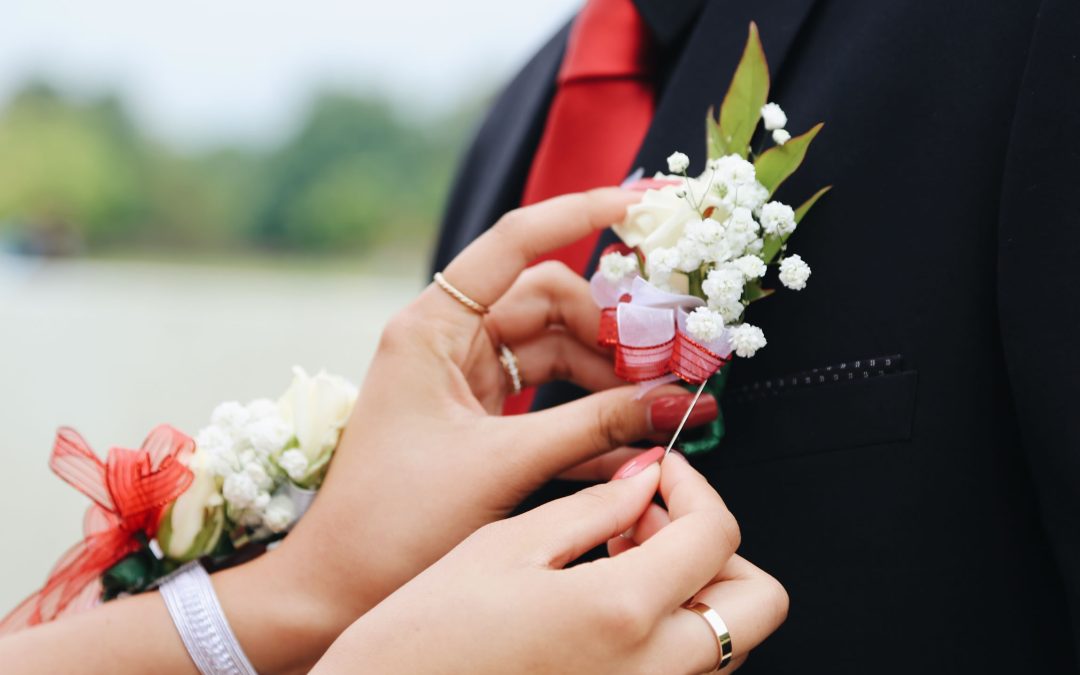Boutonnieres and corsages are important additions to formal outfits. They’re used for weddings, but they’re also used for prom and other formal events.
A boutonniere is technically a floral decoration, typically crafted in the style of a single flower or bud, that’s worn on the lapel of a suit-jacket or tuxedo.
This adornment is generally worn by men. It’s worn at weddings, for anniversaries, at formal events, or even for nights at the opera or theater.
A corsage is technically a small bouquet or arrangement of flowers worn either around the wrist or on the clothing for formal occasions — especially for some weddings, and often for prom.
This adornment is sometimes worn by the bride at a wedding, and can also be worn by the family of the bride and groom.
We all know that boutonnieres and corsages are important parts of the formal dress code.
But where did they come from?
Where did these traditions originate, and why did they become traditions in the first place?
As it turns out, there’s some interesting history in the books for these topics.
So let’s dive in and get some answers.
The History of the Boutonniere
Some sources cite that the tradition of wearing flowers as adornments dates back to the ancient civilizations of the Egyptians and the Aztecs.
It’s believed that in these cultures, people wore certain colored blossoms to show support for athletes in sporting events.
Fast forward to the fierce civil wars that took place in England during the middle ages, and there is quite a bit of evidence to support the fact that flowers (in the form of boutonnieres) were used on the field of battle — as a means for helping to identify who was ‘friend’ and who was ‘foe’ when everyone was wearing similarly styled steel armor from head to toe.
In the 19th century, boutonnieres finally fell into place as a style item. This coincided with the introduction of the lapelled jacket.
The term ‘boutonniere’ is actually French. It’s derived from the French word for ‘buttonhole flower,’ which is appropriate — seeing as how these small, stylish flower items have traditionally always been worn on the left lapel, parallel to the edge of the outer seam of the jacket.
All throughout history, flowers have been used for special occasions to symbolize good luck, beauty, and nature. But they were also used to ward off bad smells, and to ‘lighten up’ otherwise stuffy and dingy formal affairs.
During the early 1900s, it became commonplace for men to wear boutonnieres on a regular basis (when wearing suit jackets was a normal facet of style).
However, as time has progressed, and as the dinner jacket and tuxedo have moved more into a space reserved for ‘formal occasions,’ the boutonniere has followed suit.
The History of the Corsage
If we track the history of the corsage back to its earliest roots, we find that the practice of wearing them was probably invented by the ancient Greeks.
They believed that the fragrances of the flowers helped to ward off evil spirits.
In their culture, it was traditional for the bride to wear a corsage at weddings — though it was also normal for other women to either hold floral arrangements, or to attach these arrangements to their bodies (much like our modern-day version of the corsage).
Moving forward in history, you’ll find that the function of the corsage shifted to become a sort of luxury item, and a token of affection often offered by a gentleman to the lady he wished to court.
He would offer a corsage to his date as a gift for her willingness to attend the special event with him.
Sometimes, this practice involved the gifting of a floral arrangement from the man to the woman’s parents. But then, the man would remove a singular flower from the arrangement and pin it to the lady’s dress.
The term ‘corsage’ is also French. It originally referred to ‘the bodice of a dress,’ since floral arrangements were traditionally pinned to this specific part of the lady’s attire.
Of course, as we moved into the 20th century, corsages become common gifts for gentlemen to give their escorts at proms, dances, and other formal occasions.
As dresses evolved (more specifically, as spaghetti strap dresses and strapless dresses became more common), corsages also changed. Nowadays, they’re usually attached to the wrist instead of to the dress.
Conclusion
If you’re getting ready to attend a wedding, prom, or formal event, then you’re going to need a beautiful corsage and/or boutonniere to really complete your ensemble.
Linda’s Flowers carries a wide range of corsages and boutonnieres that can be specially ordered to match your suit, tux, or dress perfectly.
And if you’re not sure exactly what to get — well, stop by and let us help you pick one out.
If you have questions, you can also contact us today.
We look forward to seeing you!

